七年级英语上册 Unit 6 Do you like bananas Period Three教案 (新版)人教新目标版
- 格式:doc
- 大小:81.50 KB
- 文档页数:3
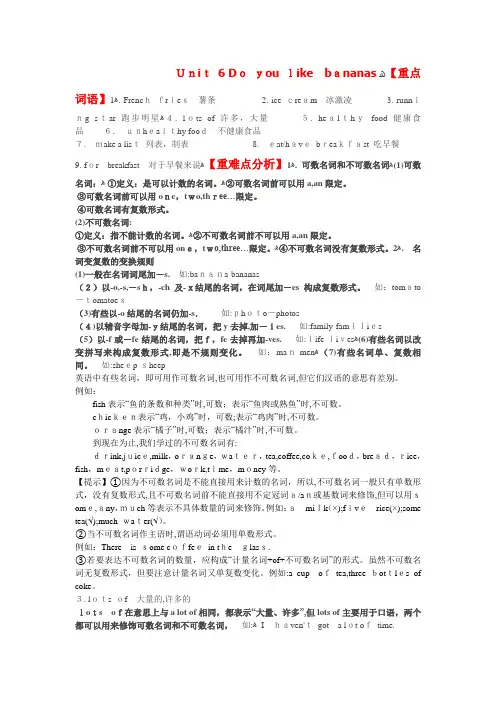
Unit 6 Doyou like bananasﻫ【重点词语】1ﻫ. Frenchfries薯条 2. ice cream冰激凌 3. running star 跑步明星ﻫ4. lots of 许多,大量5. healthyfood 健康食品6.unhealthy food不健康食品7.make a list列表,制表8.eat/havebreakfast 吃早餐9. for breakfast对于早餐来说ﻫ【重难点分析】1ﻫ. 可数名词和不可数名词ﻫ(1)可数名词:ﻫ①定义:是可以计数的名词。
ﻫ②可数名词前可以用a,an限定。
③可数名词前可以用one,two,three…限定。
④可数名词有复数形式。
(2)不可数名词:①定义:指不能计数的名词。
ﻫ②不可数名词前不可以用a,an限定。
③不可数名词前不可以用one,two,three…限定。
ﻫ④不可数名词没有复数形式。
2ﻫ.名词变复数的变换规则(1)一般在名词词尾加-s.如:banana-bananas(2)以-o,-s,-sh,-ch及-x结尾的名词,在词尾加-es构成复数形式。
如:tomato -tomatoes(3)有些以-o结尾的名词仍加-s.如:photo-photos(4)以辅音字母加-y结尾的名词,把y去掉,加-ies.如:family-families(5)以-f或-fe结尾的名词,把f,fe去掉再加-ves.如:life-livesﻫ(6)有些名词以改变拼写来构成复数形式,即是不规则变化。
如:man-menﻫ(7)有些名词单、复数相同。
如:sheep-sheep英语中有些名词,即可用作可数名词,也可用作不可数名词,但它们汉语的意思有差别。
例如:fish表示“鱼的条数和种类”时,可数;表示“鱼肉或熟鱼”时,不可数。
chicken表示“鸡,小鸡”时,可数;表示“鸡肉”时,不可数。
orange表示“橘子”时,可数;表示“橘汁”时,不可数。
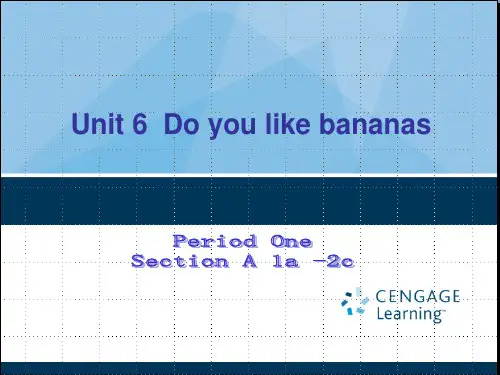


人教版七年级上册英语Unit6 Do you like bananas一. 教材分析人教版七年级上册英语Unit6 Do you like bananas主要讲述了关于喜好和食物的话题。
本节课的主要内容是让学生能够用英语询问和描述他们对不同食物的喜好。
教材通过简单的对话和词汇,帮助学生掌握基本的交际用语,并能够运用这些句子进行日常交流。
此外,本单元还引入了一般现在时态的用法,让学生能够用英语描述他们的日常喜好和习惯。
二. 学情分析在进入七年级上册时,学生们已经掌握了基本的英语语法和词汇知识,具备一定的听、说、读、写的能力。
然而,对于一般现在时态的用法和复杂的句子结构,他们可能还较为陌生。
因此,在教学过程中,需要注重引导学生理解和运用一般现在时态,并通过大量的练习和实际操作,让他们能够熟练运用该时态进行描述和交流。
三. 说教学目标1.知识目标:学生能够掌握一般现在时态的用法,并能够用英语询问和描述他们对不同食物的喜好。
2.能力目标:学生能够听懂、说出一般现在时态的句子,并能够运用该时态进行日常交流。
3.情感目标:通过小组合作和互动交流,学生能够增强自信心,提高团队合作意识。
四. 说教学重难点1.教学重点:一般现在时态的用法和食物词汇的掌握。
2.教学难点:一般现在时态的运用和食物词汇的灵活运用。
五. 说教学方法与手段1.教学方法:采用任务型教学法,通过小组合作、互动交流和实际操作,引导学生主动参与学习过程。
2.教学手段:利用多媒体教学资源,如图片、音频和视频,增加学生的学习兴趣和参与度。
六. 说教学过程1.导入:通过展示一些常见食物图片,引导学生谈论他们对食物的喜好。
2.新课呈现:引入一般现在时态的概念,并通过示例句子让学生理解一般现在时态的用法。
3.对话练习:让学生听录音或观看视频,模仿对话中的句子,并进行角色扮演。
4.小组活动:学生分组进行讨论,用英语询问和描述他们对食物的喜好。
5.巩固练习:通过完成练习题和互动游戏,让学生进一步巩固一般现在时态的用法。

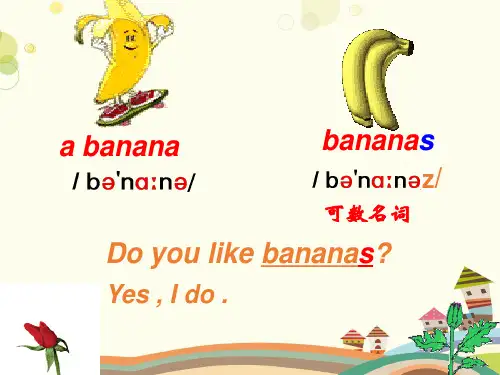
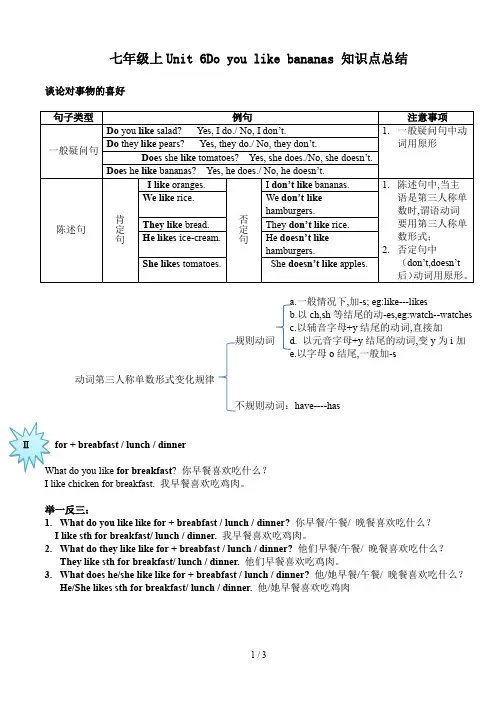
七年级上Unit 6Do you like bananas 知识点总结谈论对事物的喜好a.一般情况下,加-s; eg:like---likesb.以ch,sh等结尾的动-es,eg:watch--watchesc.以辅音字母+y结尾的动词,直接加规则动词 d. 以元音字母+y结尾的动词,变y为i加e.以字母o结尾,一般加-s动词第三人称单数形式变化规律不规则动词:have----hasfor + breabfast / lunch / dinnerfor breakfast? 你早餐喜欢吃什么?I like chicken for breakfast. 我早餐喜欢吃鸡肉。
举一反三:1.What do you like like for + breabfast / lunch / dinner?你早餐/午餐/ 晚餐喜欢吃什么?I like sth for breakfast/ lunch / dinner.我早餐喜欢吃鸡肉。
2.What do they like like for + breabfast / lunch / dinner?他们早餐/午餐/ 晚餐喜欢吃什么?They like sth for breakfast/ lunch / dinner.他们早餐喜欢吃鸡肉。
3.What does he/she like like for + breabfast / lunch / dinner?他/她早餐/午餐/ 晚餐喜欢吃什么?He/She likes sth for breakfast/ lunch / dinner.他/她早餐喜欢吃鸡肉1)可数名词、不可数名词、即可数又不可数名词2)可数名词单数变复数的规则1.一般情况下直接加-s, girls, books,2. 以s, x, ch, sh 结尾的加-es , classes, boxes, brushes,3.以辅音字母加y 结尾, 4, 以元音字母加y 结尾, 或fe 结尾, Phrases 1. birth 出生 day 日;天 birthday 生日 birthday dinner 生日聚餐 2. right 正确的;适当的 你是对的。
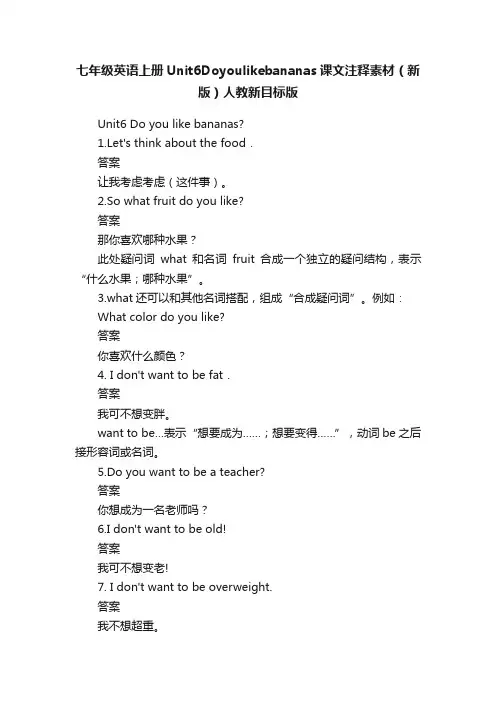
七年级英语上册Unit6Doyoulikebananas课文注释素材(新版)人教新目标版Unit6 Do you like bananas?1.Let's think about the food.答案让我考虑考虑(这件事)。
2.So what fruit do you like?答案那你喜欢哪种水果?此处疑问词what和名词fruit合成一个独立的疑问结构,表示“什么水果;哪种水果”。
3.what还可以和其他名词搭配,组成“合成疑问词”。
例如:What color do you like?答案你喜欢什么颜色?4. I don't want to be fat.答案我可不想变胖。
want to be…表示“想要成为……;想要变得……”,动词be之后接形容词或名词。
5.Do you want to be a teacher?答案你想成为一名老师吗?6.I don't want to be old!答案我可不想变老!7. I don't want to be overweight.答案我不想超重。
fat有“肥胖”之意,表达较为直接。
在英语中,人们比较忌讳使用这个词,而是委婉地改用其他说法。
8.For breakfast/lunch/dinner,I like…答案早饭/午饭/晚饭我喜欢(吃)…9.What do you have for breakfast?答案早饭你吃什么?10.We often eat rice for lunch. (=For lunch, we often eat rice.)答案我们午饭常吃米饭。
介词for与一日三餐名称搭配使用时,表示各餐所吃的食物。
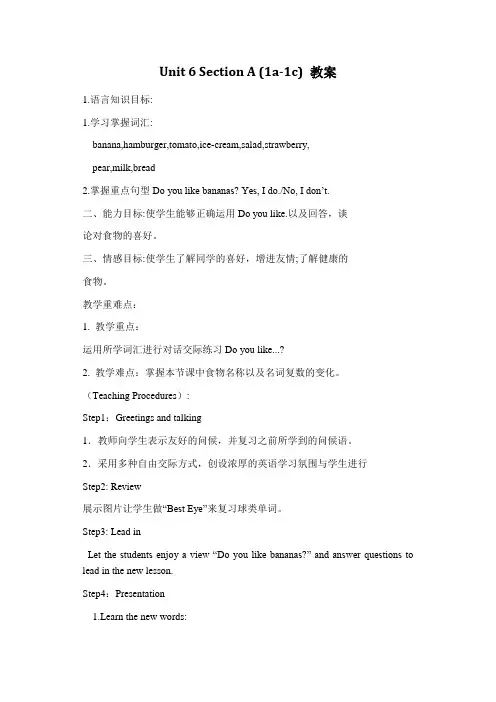
Unit 6 Section A (1a-1c) 教案1.语言知识目标:1.学习掌握词汇:banana,hamburger,tomato,ice-cream,salad,strawberry,pear,milk,bread2.掌握重点句型Do you like bananas? Yes, I do./No, I don’t.二、能力目标:使学生能够正确运用Do you like.以及回答,谈论对食物的喜好。
三、情感目标:使学生了解同学的喜好,增进友情;了解健康的食物。
教学重难点:1. 教学重点:运用所学词汇进行对话交际练习Do you like...?2. 教学难点:掌握本节课中食物名称以及名词复数的变化。
(Teaching Procedures):Step1:Greetings and talking1.教师向学生表示友好的问候,并复习之前所学到的问候语。
2.采用多种自由交际方式,创设浓厚的英语学习氛围与学生进行Step2: Review展示图片让学生做“Best Eye”来复习球类单词。
Step3: Lead inLet the students enjoy a view “Do you like bananas?” and answer questions to lead in the new lesson.Step4:Presentation1.Learn the new words:Show some pictures to learn new words of fruits and foods.2.Finish 1aLet students match the words with the things in the picture.3.Learn important sentences:展示图片进行师生互动操练重点句型:A: Do you / they like ... ?B: Yes, I/We/They do.No, I/We/They don’t.A: Does he/ she like ... ?B: Yes, he/she does.No, he/ she doesn’t.4.Pair work让学生两人一组操练重点句型:A: Do you / they like ... ?B: Yes, I/We/They do.No, I/We/They don’t.A: Does he/ she like ... ?B: Yes, he/she does.No, he/ she doesn’t.5.Finish 1bListen and number the conversations[1-3].6.Grammar:可数名词单复数变化方法讲解以及不可数名词的用法讲解7.Summary:教师带领学生回顾本节课所上的生词,句型和语法。
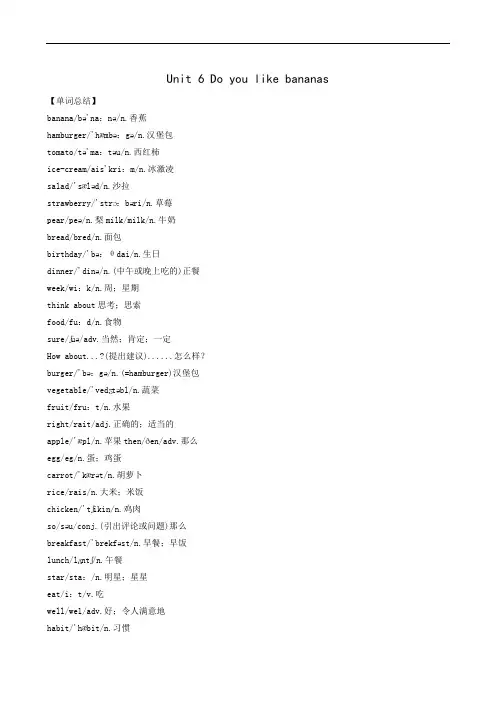
Unit 6 Do you like bananas 【单词总结】banana/bə'na:nə/n.香蕉hamburger/'hæmbə:gə/n.汉堡包tomato/tə'ma:təu/n.西红柿ice-cream/ais'kri:m/n.冰激凌salad/'sæləd/n.沙拉strawberry/'strɔ:bəri/n.草莓pear/peə/n.梨milk/milk/n.牛奶bread/bred/n.面包birthday/'bə:θdai/n.生日dinner/'dinə/n.(中午或晚上吃的)正餐week/wi:k/n.周;星期think about思考;思索food/fu:d/n.食物sure/ʃuə/adv.当然;肯定;一定How about...?(提出建议)......怎么样?burger/'bə:gə/n.(=hamburger)汉堡包vegetable/'vedʒtəbl/n.蔬菜fruit/fru:t/n.水果right/rait/adj.正确的;适当的apple/'æpl/n.苹果then/ðen/adv.那么egg/eg/n.蛋;鸡蛋c arrot/'kærət/n.胡萝卜rice/rais/n.大米;米饭chicken/'tʃikin/n.鸡肉so/səu/conj.(引出评论或问题)那么breakfast/'brekfəst/n.早餐;早饭lunch/lʌntʃ/n.午餐star/sta:/n.明星;星星eat/i:t/v.吃well/wel/adv.好;令人满意地habit/'hæbit/n.习惯healthy/'helθi/adj.健康的really/'ri:əli/adv.真正地question/'kwestʃən/n.问题want/wɔnt/v.需要;想要be/bi:/v.变成fat/fæt/adj.肥的;肥胖的【短语归纳】1.John’s birthday dinner约翰的生日宴会2.vegetable salad蔬菜沙拉3.two tomatoes两个西红柿4.eat well吃得营养5.think about考虑6.eat/have breakfast/lunch/dinner吃早/午/晚饭7.sports stars体育明星8.the volleyball star排球明星9.ask sb.about sth.问某人某事10.like hamburgers/ice-cream喜欢汉堡包/冰淇淋11.like eating eggs喜欢吃鸡蛋12.her eating habits她的饮食习惯13.be(not)healthy(不)健康14.one last question最后一个问题15.healthy food健康食物16.after breakfast/lunch/dinner早/午/晚饭后。
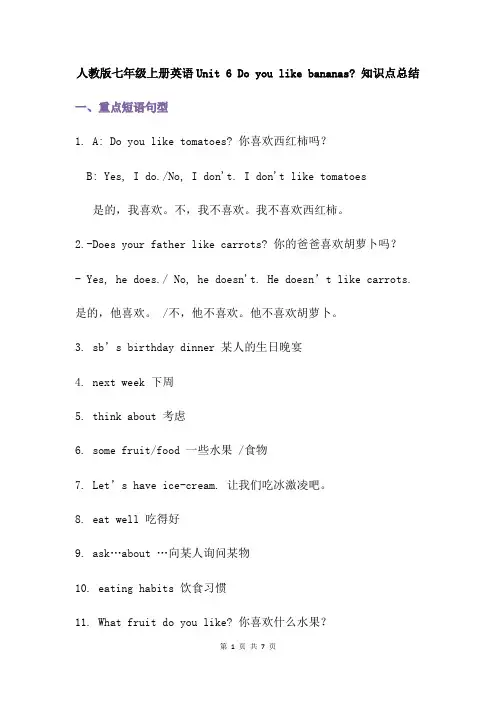
人教版七年级上册英语Unit 6 Do you like bananas? 知识点总结1. A: Do you like tomatoes? 你喜欢西红柿吗?B: Yes, I do./No, I don't. I don't like tomatoes 是的,我喜欢。
不,我不喜欢。
我不喜欢西红柿。
2.-Does your father like carrots? 你的爸爸喜欢胡萝卜吗?- Yes, he does./ No, he doesn't. He doesn’t like carrots. 是的,他喜欢。
/不,他不喜欢。
他不喜欢胡萝卜。
3. sb’s birthday dinner 某人的生日晚宴4. next week 下周5. think about 考虑6. some fruit/food 一些水果 /食物7. Let’s have ice-cream. 让我们吃冰激凌吧。
8. eat well 吃得好9. ask…about …向某人询问某物10. eating habits 饮食习惯11. What fruit do you like? 你喜欢什么水果?12. for breakfast/lunch/dinner 就早 /午/晚餐而言13. It’s healthy. 它是健康的。
14. I really like it. 我真的喜欢它。
15. I like chicken for dinner. 晚餐我喜欢吃鸡肉。
16. one last question 最后一个问题17. after dinner 晚饭后18. I don’t want to be fat. 我不想变胖。
1、Do you like hamburgers? 你喜欢汉堡包吗?Yes, I do. No, I don’t是的,我喜欢。
/ 不,我不喜欢。
2、I like French fries. 我喜欢在薯条。
七年级英语上册Unit6Doyoulikebananas题型总结及解题方法单选题1、There are many kinds of ________ in the river. You can go _________ there.A.fishes; fishingB.fishes; fishC.fishs; fishingD.fish; to fish答案:A句意:河里有许多种类的鱼,你可以去那钓鱼。
考查名词的数和动词短语。
根据“ many kinds of ”可知这里表示很多种类的鱼,“fish”强调种类的时候可数,故这里用复数;根据“You can go”可知这里考查短语go fishing“去钓鱼”。
故选A。
2、So many factories are here. Maybe there will be much ________ in the air here. A.polluteB.pollutionC.pollutedD.more polluted答案:B句意:这里有如此多的工厂。
也许这里的空气中将会有许多污染物。
考查不可数名词。
pollut e“污染”,动词;pollution“污染物”,不可数名词;polluted“污染”,动词过去式/过去分词;more polluted“被污染更严重的”,形容词比较级。
根据“there will be much...in the air”意为“空气中将会有更多的……”,结合句意以及much修饰不可数名词的用法,空格处应填入不可数名词。
故选B。
3、I'd like some_____and_____.A.banana; tomatoB.bananas; tomatoC.bananas; tomatoesD.banana; tomatoes答案:C句意:我想要一些香蕉和西红柿。
我们知道some后面应该跟可数名词的复数,或不可数名词;banana和tomato是可数名词,应该用复数,所以A不对;选项B的tomato没有用复数,所以不对;选项D的banana没有用复数,所以不对;故选C。
七年级英语上册Unit 6 Do you like bananas?知识点整理七年级英语上册unit 6 do you like bananas?知识点整理1. like 喜欢1)like sb. / sth.喜欢某人/某物2) like to do sth.喜欢/想要做某事(表一次性或特指的某一具体的动作)3) like doing sth喜欢做某事(表习惯性的动作或爱好)①我喜欢每天打篮球。
i like playing basketball every day.②今天很冷,我喜欢呆在家里。
today is cold, i like to stay at home.2. do you like bananas? 你喜欢香蕉吗。
可数名词可用复数表示一类人或事物3. 名词的分类1)名词分为“专有名词”和“普通名词”两大类。
专有名词是个别的人、事物、地点等专有的名称,如:gina, china。
专有名词的第一个字母要大写。
2)普通名词又可分为下面四类:①个体名词:表示某类人或东西中的个体。
如pen, student, apple。
②集体名词:表示若干个体组成的集合体。
如family, class。
③物质名词:表示无法分为个体的物质。
如water, broccoli等。
④抽象名词:表示动作、状态、品质、情感等。
如work, happiness等。
个体名词和集体名词都是可数名词,物质名词和抽象名词都是不可数名词。
3)有些名词既可作可数名词又可作不可数名词,但意义不同,要注意区分。
①glass c. 杯子 u 玻璃 orange c 橘子 u. 橘汁②还有表示动物类的名词,表示动物时是可数名词,作为菜肴时是不可数名词。
chicken c 小鸡 u 鸡肉 fish c.鱼 u. 鱼肉③salad, ice cream, food, fruit 作总称讲是不可数名词,作种类讲是可数名词she likes hamburgers, salad and apples.a salad of tomato4. good / well1) good adj “好的”,常用来修饰名词。
七年级英语上册《Unit 6 Do you like bananas》教案过询问他人喜好的食物和事物Teaching design:Period 1: Section A (1a—1c)Period 2: Section A (3a,3b)+Section B(1a—1c)Period 3: Section B(2a—3c)Period4: Self-checkPeriod 1: Section A (1a—1c)Teaching aims:1.学会日常生活中食物水果的名称2.学会谈论对食物水果的喜好Language points:1.要求掌握以下句式(1)Do you like┅ Yes I do/No I don’t(2)I like┅ I don’t like2.要求掌握以下词汇knowledge tomatoes broccoli French fries oranges ice cream salad bananas strawberries carrotsDifficulties(1) 可数名词和不可数名词(2) 可数名词的复数形式Teaching steps1.warning-up and revision1) Daily greeting to the students2) Revision(复习) I have┅ Do you have ┅?T: Good morning /afternoon/children (showing a ) fruit basketI have a fruit basket Do you have a fruit basketAsk the students to ask and answer using the pattern::Do you have┅?2. Guessing gamesTaking away the fruit basket and asking the students to guess: What’s in the basket? Using the sentence: Do you have┅? Present the names of all kinds of fruits and food3. Showing a picture of fridge in the computerRevise the names of food and fruitTeach the new words of food and fruit4. Practise1a. match the words with the pictures2a. Listen and circle the food you hear5. Show the picture again or take out an apple, act out eating an appledelicious and say:I like apples for several times then take an egg, “Idon’t like eggs”for several times, working a horrible face at them (Ask more questions about fruits and food )6.Guessing gameGuess what my favourite food is, or ask some students to come to the front and guess what her/his favourite food is.7. Fill in the chartAsk the students to talk about their likes and dislikes in talking pairs9. Listening1b. Listen and number the conversation10. HomeworkOral work:Recite the new wordsWritten work:1. Copy the new words in Section A;2. Making up dialogues between you and your parents about likes and dislikes板书设计:Countable nouns Uncountable nouns Countable and uncountable nouns hamburgers, broccoli, ice cream,strawberries, rice, salad,French fries, coffee, chicken,………教学反思:Period 2: Section A (2a—4)Teaching aims:1 学会谈论第三人称(he/she)的喜好2 巩固有关食物的单词Language points:1. 要求掌握以下句子(1)—Does she/he like apples?—Yes,she/he does,she/he likes apples.—No,she/he doesn`t,she/he doesn`t like apples. (2)—Do they like apples?—Yes,they do,they like apples.—No ,they don`t .Thet don`t like apples.2. Difficulties(1)Does……do sth?的动词要用原形(2)He/She likes apples.中的动词后一定要加“s”Teaching steps:1 Warming-up and revision1) Play a guessing gameT:show pictures of food,drinks,fruits fast.Ss:guess one by one and spell it.T:check it and show the correct spelling on the right.Listen(to 2b)and fill in the form (Ask S2 to read the dialogue to check the answer)2 Presentation(From the listening material we know the boy`s and the girl`s likes and dislikes.Now I want to know what you like and dislike)(1)T:(To a boy student)Do you like tomatoes?S1:Yes,I do.T:(To Ss)Does he like tomatoes?Ss:Yes,he does. He likes tomatoes.(Ss look at the screen and read them again)T:(To St2)Do you like salad?St2:No,I don`t.T:(To Ss)Does he like salad?St2:(helped by the teacher)No,he doesn`t. He doesn`t like salad.(Ss look at the screen and read them again)(2)T:(To a girl student)Do you like ice cream?S1:Yes,I do.T:(To the Ss)Does she like ice cream?Ss:Yes,she does. She likes ice cream.(Ss look at the screen and read them again)T:(To S2)Do you like tea?S2:No,I don`t.T:(To Ss)Does she like tea?Ss:No,she doesn`t. She does like tea..3. Practice(1)Ss do the same as the teacher.(2)Ss practise them in groups. Ask Ss to act it out.(3)Ask Ss to write out his partner`s 2 likes and 2 dislikes.(4)Let Ss have a competition between the girls and boys using the key phrases.(T gives an example) Does she/he like……?S1:(look at the student`s sentence)Yes,he does. He likes……No, he doesn`t. He doesn`t like……)(5)Summarize the competition4. Presentation and practice(1) T show pictures of 姚明and刘翔and ask:Who are they?Ss:They are ……T :Do th ey like carrots?(Ss may know but most don`t .T ask Ss to look at the chart andgive their answers)N o……(2)T show pictures of郭晶晶and蔡依林and ask :Who are they?5 Work on Part3(P33)(1)SA look at Page33 and ask questions and fill in the blanks.(2)SB look at Page83 and ask questions and fill in the blanks.(3)Ask 2 pairs to read out their answers.6. Make a food surveyT:I`m going to have a birthday party,so I want to buy some food, fruits and drinks.Please help me find out what they like and don`t like and finish the chart.Ss finish the chartT ask S4 to report their survey to the teacher.He/She like… They don`t like… He/She doesn`t like……7. Homework(1)Make an interview to you friend about his father and mother`s likes and dislikes and record it.(with the key phrases)(2)Finish 《全品》Section A板书设计:—Does she/he like apples?—Yes,she/he does,she/he likes apples.—No,she/he doesn`t,she/he doesn`t like apples.—Do they like apples?—Yes,they do,they like apples.—No ,they don`t .Thet don`t like apples.教学反思:Period 3: Section B (1a—2C, 4a-4b)Teaching aims:1.巩固所学的食物及水果名词。
Unit 6 Do you like bananas?
Period Three
课前准备
教师:搜集关于食物的图片,多媒体教学课件,制作表格(见教学步骤)。
学生:准备上一节课的家庭作业。
教学设计
Step One: Check the .)
Step Twp: Review the words.
T:You know we ask someone to say.)
S: Salad, apples, bananas, ice cream…
(Choose the three students who said the most and give some food as presents.) Step Three: New words.
①Present the new words.
T:How many meals do you answer them in Chinese.)
Ss:They are “早餐、中餐和晚餐”.
T:Oh, yes. In English “早餐”we can say “breakfast”.
(Show a picture of the breakfast)
Read after me, “breakfast”.
B-R-E-A-K-F-A-S-T,breakfast.
Ss: B-R-E-A-K-F-A-S-T,breakfast.
T:Do you the same way.)
②Practice the words.
T:Which meal do you like best?(Point to a student.)
S:I like breakfast best.
T:Why?
S:Because I like drinking milk.
T:Who also likes breakfast in our class? Please put up your sit in this team. (Ask all the students who like breakfast, lunch or dinner to come to the same team.
They can talk easily.)
T:We it?
Let’s talk about it. Try to find the food what your group like most and tell us the reason.
(When each group is talking about it, the teacher goes around among the students and ask each group to report.)
S:In our group, we like breakfast best. We all like oranges, eggs, milk and an apple.Because they are good for our the student is saying, the teacher puts the food onto the plate for breakfast.)
(Do it for lunch and dinner in the same way.)
T:Look at 1a, and write the number in the box next to the correct food.
(Then the students finish off 1a.)
T:How many other food words can you add to the chart?
Try to write them down in the chart.
(The students write them down as soon as possible and then read them. See who will add most.)
Step Four: Practice the listening.
T: Look! There are so many foods. Maybe they are very delicious. Which food do you like? Do you like apples? (Show the picture.)
S1: …
T: How about chicken? Do you like it ?
S1: …
T: Can you guess what food I like?
S1: Do you like…?
T: No, I don’t.
S2: Do you like…?
S3: Do you like…?
T: Yes, you are right. I think you are very lucky. But I and find out the food you Section B. The students find out each food mentioned in the conversation on the recording. Then check the answers.)
T: Now open your books and listen again. Fill in the chart.
(Play the recording the first time. Students listen to the conversation and write in the answers on their charts. Play the recording the second time and then the students can check their answers to be sure they are correct.)
T: Does Sandra like salad?
S: Yes, she does.
T: Work in pairs about the chart.
Step Five: Task.
Go on a picnic with a group of friends and make a list of food to buy.
①Divide the students into six groups.
②Talk about what the students in your group like and dislike and make a list.
③The leader in each group reports to the class.
Step Six: Summary and homework.
Make a survey about “What do your parents like for three meals?” after class.。